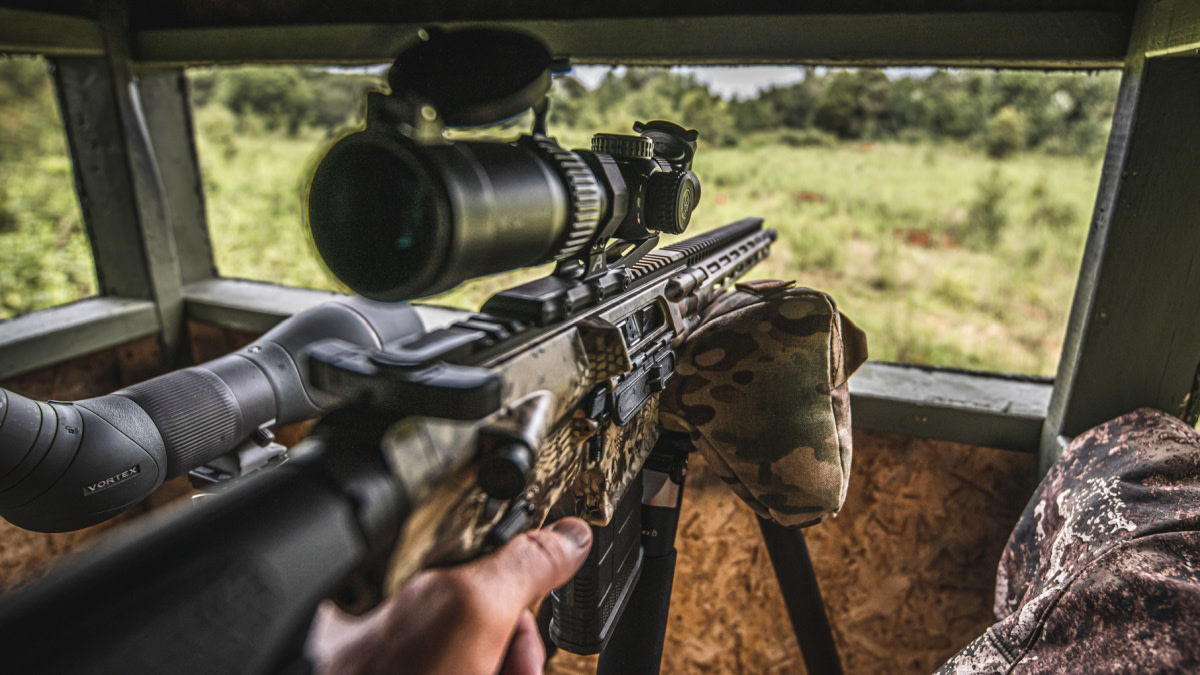
As AR-15 rifles have become more popular among casual shooters, hunters have wondered if it's the right platform for their next deer gun. So, we're here to break down the pros and cons of toting an AR on your next hunt.
Some of these will apply to other kinds of semi-automatic rifles like the AK-47 or the Sig Sauer MCX. Also keep in mind that we’re not talking about the pros and cons of the .223 Remington cartridge. We’ve covered that here, and AR-platform rifles can be bought or built in most popular hunting cartridges.
Instead, we’re considering the AR-15’s functionality to make the case for and against America’s most popular rifle as a hunting firearm.
Pro #1: Semi-Auto Fire This is the first and most obvious advantage an AR-15 can provide over other types of bolt-, lever-, or pump-action rifles. Semi-auto systems come with their own set of complications (more on that below), but the ability to quickly pull the trigger more than once is without question a benefit in certain hunting situations. It's why varmint hunters love this platform.
Deer hunters pride themselves on not needing more than one shot to take down an animal, but no one’s perfect. Hunt long enough and you’re sure to find yourself eventually making an ill-placed shot that necessitates a follow-up. An AR-15 gives hunters the ability to make a second shot in a fraction of a second which could mean the difference between a lost animal and venison sausage.
Pro #2: Modularity and Customizability AR-15s are occasionally compared to Legos—and with good reason. The rifle system is infinitely customizable by even the most amateur gunsmith. From the stock to the trigger to the handguard, everything on an AR-15 can be upgraded to meet a specific goal or application.
A single lower receiver, for example, can accept different upper receivers fitted with barrels chambered in different calibers. A hunter can use an upper chambered in .223 Rem. for prairie dogs or other varmint and swap it out for an upper chambered in .300 Blackout for hogs or whitetails. Hunters can also build super-light rifles for mountain hunts or bull-barrel rifles for long-range or stand hunting.
Triggers are another great potential upgrade. Aftermarket triggers for bolt-action rifles are sometimes expensive or difficult to install, but AR triggers are sold at many price points and can be installed in minutes.
Pro #3: Weight and Maneuverability AR-15s tend to weigh less than bolt-action rifles and the adjustable stock allows hunters of different sizes to use the same gun. Both are great features for new and young hunters who might be turned off by a rifle that doesn’t fit them properly or is too heavy to carry or hold comfortably.
It’s true that the AR-15 profile has more sharp edges and snag spots than the traditional deer rifle. But 5- or 10-round magazines can streamline the profile, and I would argue that the pistol grip’s benefits outweigh its costs. Sure, the grip might snag on a branch or a vine occasionally, but that happens so rarely (and to such little effect) that the added control and maneuverability outweigh that downside.
Con #1: Aesthetics For many hunters, an AR-15 looks out of place in the deer woods. The traditional hunter doesn’t carry a black and polymer semi-automatic rifle. They carry a wood-stock, bolt-action rifle or, more recently, a polymer stock painted in camo or flat dark earth.
AR-15s are becoming more widely accepted by hunters across America, but bucking the tradition of a wood-stock, bolt-action that looks like something grandpa shot is a real deal breaker for some whitetailers.
Con #2: Reliability Coming full circle to Pro #1, the semi-auto action is more likely to malfunction than simpler action designs.
With proper maintenance and ammunition selection (not to mention practice), this con can be almost totally mitigated. Still, an AR-15 can jam or malfunction in multiple ways: failure to feed, failure to extract, or double-feed, to name a few.
If a hunter has trouble loading a round into a bolt-action rifle, they can still slide a single round in the chamber and pull the trigger. A jammed AR-15 may require more steps to get it back in the game.
Last Shots This is hardly a comprehensive catalogue of the reasons you may or may not want to bring an AR-15 to the deer woods.
Among the cons we didn’t mention is the possibility that the detachable magazine could fall out during a hunt, or how ARs present more ease-of-use concerns than bolt- or lever-action rifles. Additional pros include reduced recoil and the ability to easily install optics, suppressors, and other accessories.
It’s also a myth that AR-15s aren’t accurate enough to use on a hunt or that they cost more (or less) than other hunting rifles. These days, you don’t have to spend too much money to buy or build an AR-15 that shoots better than you do. Small and large manufacturers make AR-15s at virtually any price point.
If you do choose to use an AR-15 on your next deer hunt, you won’t be alone. According to a 2014 survey of hunters by the National Shooting Sports Foundation, 27% reported having used an AR-15 to hunt, and 58% of those used one in the last year. Given the continuing rise in sales of AR-type rifles, the percentage today is likely much higher.

Conversation